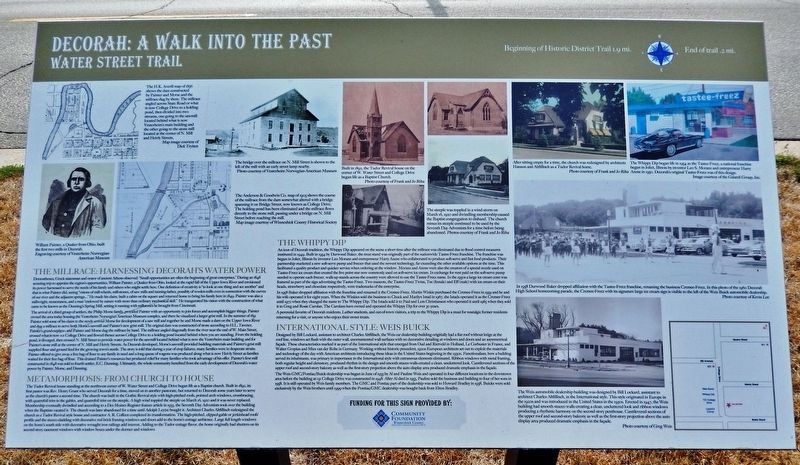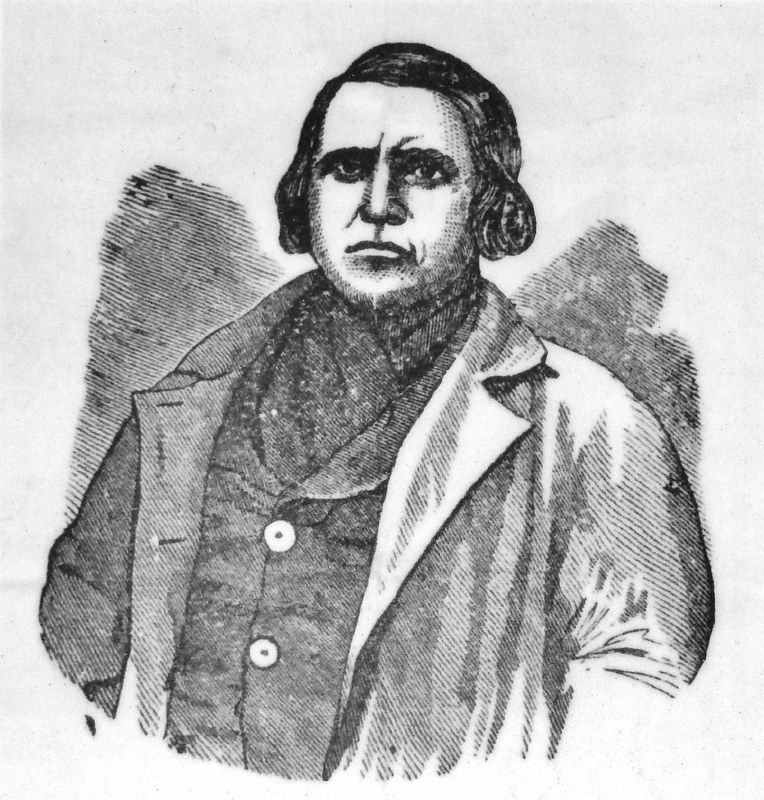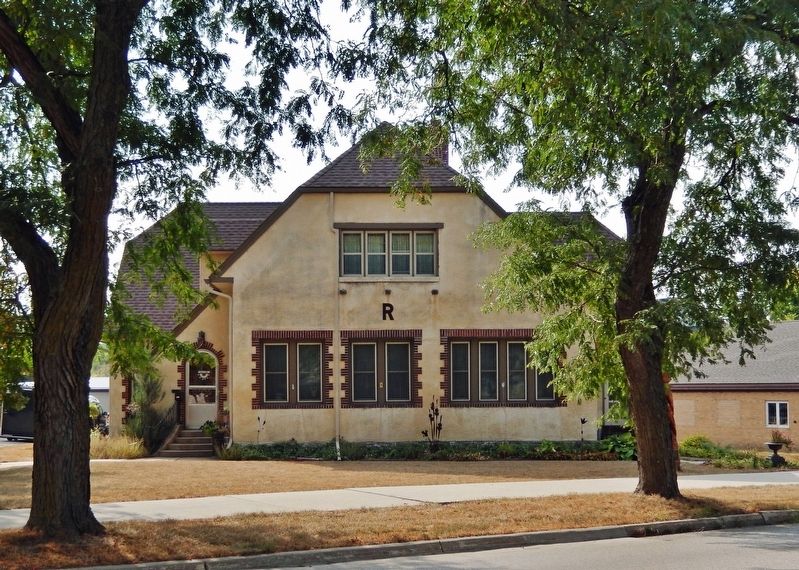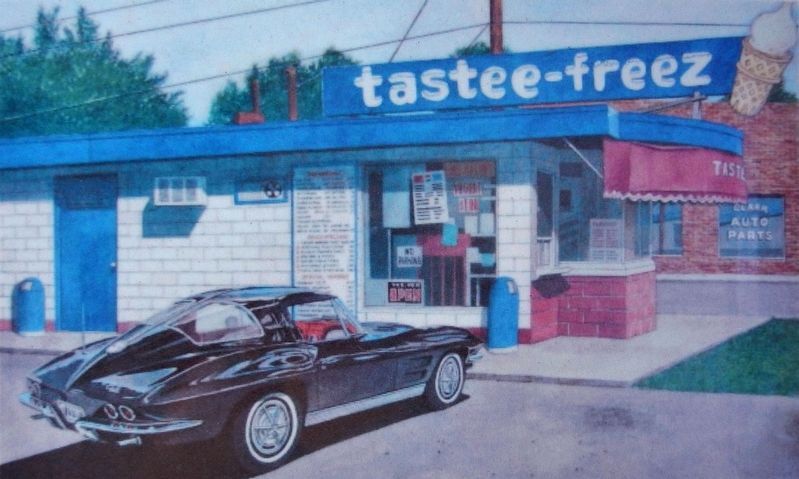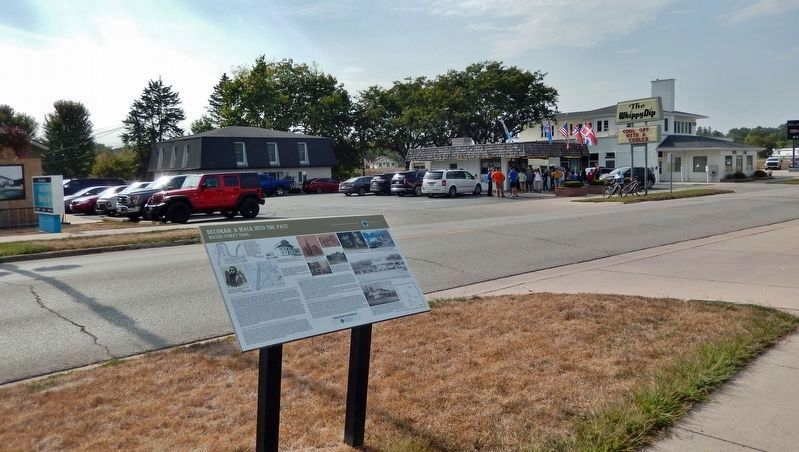Decorah in Winneshiek County, Iowa — The American Midwest (Upper Plains)
Decorah: A Walk into the Past
Water Street Trail
The Millrace: Harnessing Decorah’s Water Power
Demosthenes, Greek statesman and orator of ancient Athens observed: "Small opportunities are often the beginning of great enterprises." During an 1848 scouting trip to appraise the region's opportunities, William Painter, a Quaker from Ohio, looked at the rapid fall of the Upper Iowa River and envisioned its power harnessed to serve the needs of his family and others who might settle here. One definition of creativity is “to look at one thing and see another” and that is what Painter did, seeing "visions of mill-wheels, mill-stones, of saw mills and tanning-lathes, possibly of woolen-mills even in connection with the curves of our river and the adjacent springs..." He made his claim, built a cabin on the square and returned home to bring his family here in 1849. Painter was also a millwright, stonemason, and a man "endowed by nature with more than ordinary mechanical skill." He inaugurated his vision with the construction of what came to be known as the Dunning's Spring Mill, setting it running with millstones he brought from Cincinnati.
The arrival of a third group of settlers, the Philip Morse family, provided Painter with an opportunity to join forces and accomplish bigger things. Painter owned the area today housing the Vesterheim Norwegian American Museum complex, and there he visualized a larger grist mill. In the summer 1851 Painter sold some of his claim to the newly arrived Morse for development of a saw mill and together he and Morse made a claim on the Upper Iowa River and dug a millrace to serve both Morse's sawmill and Painter's new grist mill. The original dam was constructed of stone according to H.L. Tavener, Painter's grand-nephew, and Painter and Morse dug the millrace by hand. The millrace angled diagonally from the river near the end of W. Main Street, crossed what is now 101 College Drive and flowed thence across College Drive to a holding pond located behind where you are standing. From the holding pond, it diverged, then crossed N. Mill Street to provide water power for the sawmill located behind what is now the Vesterheim main building and for Painter's stone mill at the corner of N. Mill and Heivly Streets. As Decorah developed, Morse's sawmill provided building materials and Painter's grist mill supplied flour and ground feed for the growing town's needs. The story is told that during a year of crop failures, many families were in desperate straits. Painter offered to give away a free bag of flour to any family in need and a long queue of wagons was produced along what is now Heivly Street as families waited for their free bag of flour. This drained Painter's resources but produced relief for many families who
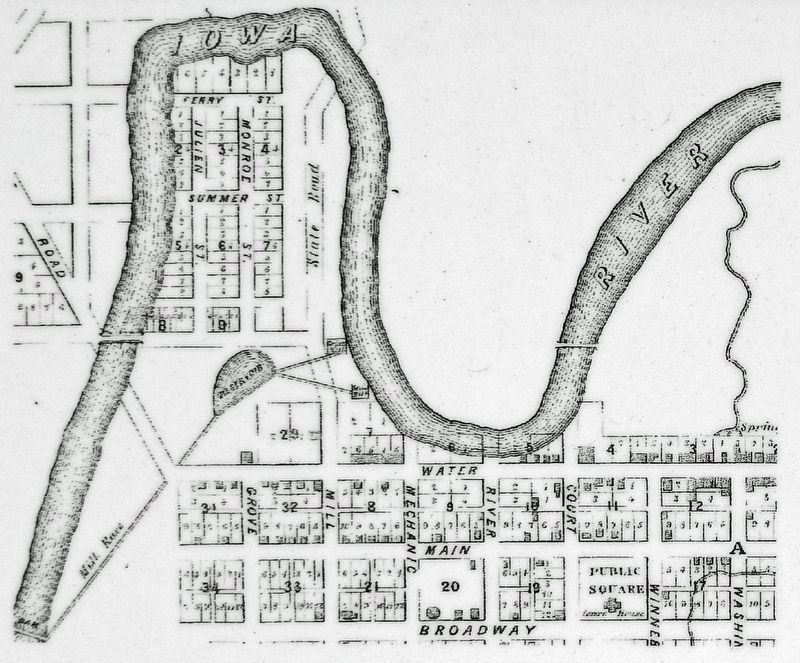
Courtesy Dick Trytten
2. Marker detail: H.K. Averill map of 1856
The H.K. Averill map of 1856 shows the dam constructed by Painter and Morse and the millrace dug by them. The millrace angled across State Road or what is now College Drive to a holding pond, then divided into two streams, one going to the sawmill located behind what is now Vesterheim's main building and the other going to the stone mill located at the corner of N. Mill and Heivly Streets.
Metamorphosis: From Church to House
The Tudor Revival house standing at the northwest corner of W. Water Street and College Drive began life as a Baptist church. Built in 1892, its first pastor was Rev. Henry Grant who served Decorah for a time, moved on to another pastorate, but returned to Decorah some years later to serve as the church's pastor a second time. The church was built in the Gothic Revival style with high-pitched roofs, pointed arch windows, crossbracing with quatrefoil trim in the gables, and quatrefoil trim on the steeple. A high wind toppled the steeple on March 16, 1920 and it was never replaced. Membership eventually dwindled and according to a Des Moines Register feature article in 1933, the Seventh Day Adventists took over the building when the Baptists vacated it. The church was later abandoned for a time until Adolph Leytze bought it. Architect Charles Altfillisch redesigned the church as a Tudor Revival style house and contractor A. R. Coffeen completed its transformation. The high-pitched, clipped-gable or jerkinhead roofs’ profile and the stucco cladding with decorative red brick
framing windows and doors add to the home's cottage ambience. Large full length windows on the home's south side with decorative wrought iron railings add interest. Adding to the Tudor cottage flavor, the home originally had shutters on its second story easement windows with window boxes under the dormer and windows.
The Whippy Dip
An icon of Decorah tradition, the Whippy Dip appeared on the scene a short time after the millrace was eliminated due to flood control measures instituted in 1949. Built in 1954 by Durwood Baker, the treat stand was originally part of the nationwide Tastee-Freez franchise. The franchise was begun in Joliet, Illinois by inventor Leo Moranz and entrepreneur Harry Axene who collaborated to produce soft-serve and fast food products. Their partnership marketed a new soft-serve pump and freezer that used the newest technology, far exceeding the other available options at the time. This facilitated a quality product and quicker service when ordering at the window. Moranz and Axene were also the creators of a special nozzle used on Tastee-Freez ice cream that created the five point star now commonly used on soft-serve ice cream. In exchange for rent paid on the soft-serve pump needed to operate each freezer, walk-up stands across the country were allowed to use the Tastee-Freez name. In the 1950s a large ice cream cone was featured
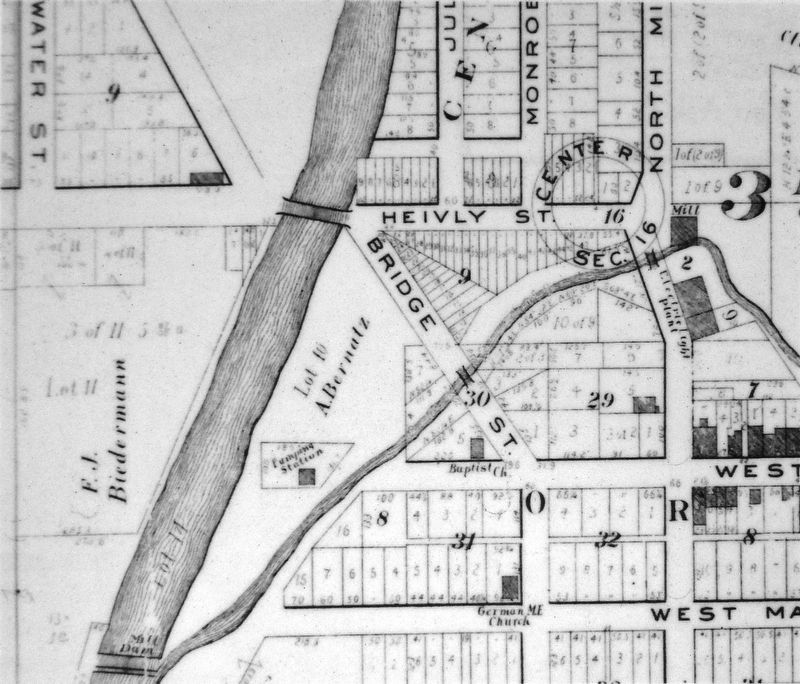
Winneshiek County Historical Society
4. Marker detail: Anderson & Goodwin Co. map of 1905
The Anderson & Goodwin Co. map of 1905 shows the course of the millrace from the dam somewhat altered with a bridge spanning it on Bridge Street, now known as College Drive. The holding pond has been eliminated and the millrace flows directly to the stone mill, passing under a bridge on N. Mill Street before reaching the mill.
In 1958 Baker dropped affiliation with the franchise and renamed it the Cremee-Freez. Martin Winkie purchased the Cremee-Freez in 1959 and he and his wife operated it for eight years. When the Winkies sold the business to Chuck and Marilyn Istad in 1967, the Istads operated it as the Cremee-Freez until 1972 when they changed the name to The Whippy Dip. The Istads sold it to Paul and Lois Christianson who operated it until 1985 when they sold it to Greg and Rosie Carolan. The Carolans have owned and operated the Whippy Dip for over 30 years.
A perennial favorite of Decorah residents, Luther students, and out-of-town visitors, a trip to the Whippy Dip is a must for nostalgic former residents returning for a visit, or anyone who enjoys their sweet treats.
International Style: Weis Buick
Designed by Bill Lockard, assistant to architect Charles Altfillisch, the Weis car dealership building originally had a flat roof without ledge at the roof line, windows set flush with the outer wall, unornamented wall surfaces with no decorative detailing at windows and doors and an asymmetrical facade. These characteristics marked it as
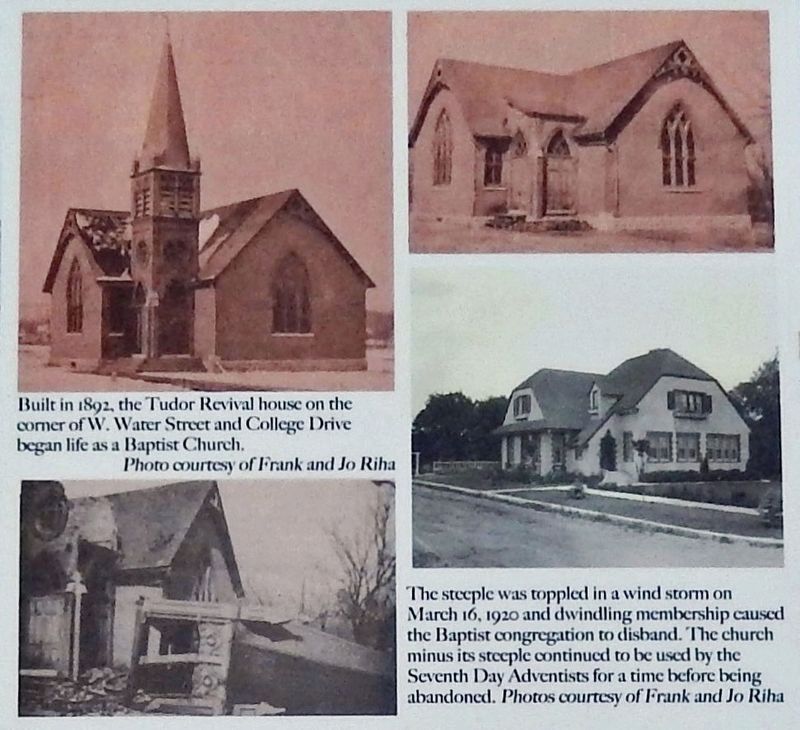
Courtesy Frank and Jo Riha
5. Marker detail: 1892 Baptist Church becomes a Tudor House
Built in 1892, the Tudor Revival house on the corner of W. Water Street and College Drive began life as a Baptist Church.
The steeple was toppled in a windstorm on March 16, 1920, and dwindling membership caused the Baptist congregation to disband. The church minus its steeple continued to be used by the Seventh Day Adventists for a time before being abandoned.
The Weis GMC/Pontiac/Buick dealership was begun in June of 1933 by Al and Pauline Weis and operated in four different locations in the downtown area before the building at 131 College Drive was constructed in 1948. After Al died in 1953, Pauline sold the business and building to four of her sons in 1958. It is still operated by Weis family members. The GMC and Pontiac part of the dealership was sold to Howard Bradley in 1938. Buicks were sold exclusively by the Weis brothers until 1999 when the Pontiac/GMC dealership was bought back
from Elton Bradley.
[other photo captions]
• The bridge over the millrace on N. Mill Street is shown to the left of the mill with an early street lamp nearby.
Topics. This historical marker is listed in these topic lists: Architecture • Churches & Religion • Industry & Commerce • Settlements & Settlers. A significant historical year for this entry is 1848.
Location. 43° 18.287′ N, 91° 47.634′ W. Marker is in Decorah, Iowa, in Winneshiek County. Marker is on College Drive (County Highway W38) just north of West Water Street, on the right when traveling north. Touch for map. Marker is in this post office area: Decorah IA 52101, United States of America. Touch for directions.
Other nearby markers. At least 8 other markers are within walking distance of this marker. Bethania Church (about 400 feet away, measured in a direct line); Rovang Schoolhouse (about 500 feet away); Egge-Koren House (about 500 feet away); Timber Framing (about 500 feet away); Conservation (about 500 feet away); Stabbur (about 500 feet away); Haugan House (about 500 feet away); a different marker also named Decorah: A Walk into the Past (about 500 feet away). Touch for a list and map of all markers in Decorah.
Related markers. Click here for a list of markers that are related to this marker.
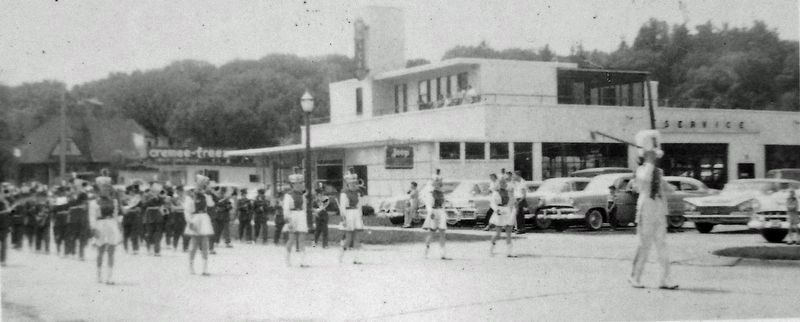
Courtesy Kevin Lee
8. Marker detail: Cremee-Freez
In 1958 Durwood Baker dropped affiliation with the Tastee-Freez franchise, renaming the business Cremee-Freez. In this photo of the 1960 Decorah High School homecoming parade, the Cremee-Freez with its signature large ice cream sign is visible to the left of the Weis Buick automobile dealership.
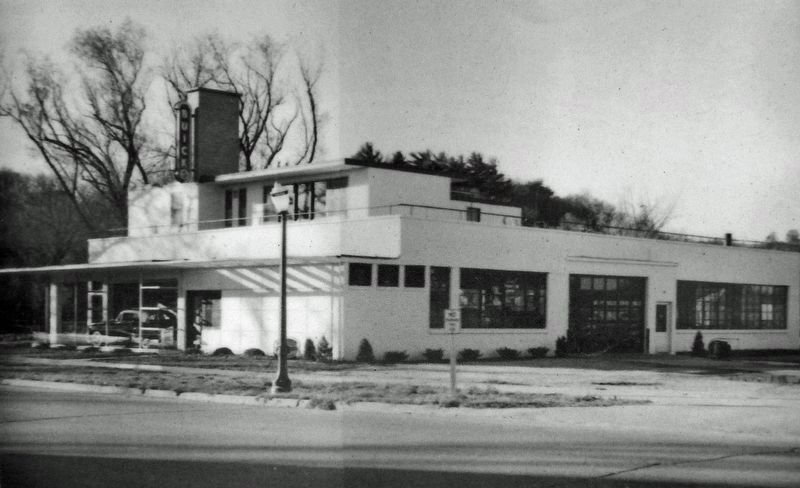
Courtesy Greg Weis
9. Marker detail: Weis Buick
The Weis automobile dealership building was designed by Bill Lockard, assistant to architect Charles Altfillisch, in the International style. This style originated in Europe in the 1920s and was introduced in the United States in the 1930s. Erected in 1947, the Weis building had smooth stucco walls creating a clean, uncluttered look and ribbon windows producing a rhythmic harmony on the second story penthouse. Cantilevered sections of the upper roof and second-story balcony as well as the first-story projection above the auto display area produced dramatic emphasis in the façade.
Credits. This page was last revised on January 26, 2024. It was originally submitted on January 25, 2024, by Cosmos Mariner of Cape Canaveral, Florida. This page has been viewed 53 times since then. Photos: 1, 2, 3, 4, 5, 6. submitted on January 25, 2024, by Cosmos Mariner of Cape Canaveral, Florida. 7, 8, 9, 10. submitted on January 26, 2024, by Cosmos Mariner of Cape Canaveral, Florida.
